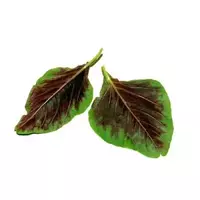Amaranth leaves

Amaranth (Amaranthus) or otherwise squint is a widespread genus of herbaceous plants (mainly annual), which differ in rather small flowers in the form of dense spike-panicle inflorescences. This plant belongs to the Amarantov family, of which up to 65 species are known.
Certain species of amaranth (Amaranthus blitum, Amaranthus retroflexus and others) are fairly common weeds, while Amaranthus paniculatus and Amaranthus caudatus, for example, are the oldest crops that are bred in some countries. By the way, in East Asia, Amaranthus mangostanus and Amaranthus gangeticus are cultivated as a vegetable plant, and other subspecies with dangling inflorescences and brightly colored leaves are relevant for decorative purposes.
In some countries, amaranth seeds, similar to sesame seeds, are used to make sweets (Mexican sweetness alegria and Indian - lada), cookies, crackers and pancakes. In Nepal, for example, porridge sattoo is brewed on the basis of amaranth raw materials, and Peruvians - beer.
In cooking, amaranth leaves are also widely used, which can be boiled, steamed or simply consumed as fresh greens. In particular, amaranth leaves are popular in Indian cuisine, in particular in the south. Mostly amaranth leaves can be found in curry and soups. They are highly valued for their variegated colors (red, green and two-color) and rather specific taste.
In terms of nutrition and taste, amaranth leaves resemble spinach, but differ from other vegetable crops and herbs in their considerable content of easily digestible protein. In addition, vitamin C and carotene are present in the amaranth leaves. As a rule, fresh amaranth leaves are used for food, suitable for consumption almost throughout the summer period.
Making fresh amaranth leaves is quite simple: first of all, you can flash them for a few minutes, and then add them to the salad, side dish and snack. Amaranth leaves are incredibly tasty if you butter them with butter, grated cheese, boiled egg or spritz.
Many hostesses use a decoction of amaranth leaves when preparing soups and borscht - due to the bright beet color, they act as a natural food dye. You can simply pull out a whole amaranth bush along with the root, and then dry it, grind it and add it to brew a very tasty, fragrant and incredibly useful tea drink. And when you add just one amaranth leaf to the jar to pickled cucumbers, the fruits keep fresh and do not soften until spring.
amaranth leaves 23 kCal
Energy value of amaranth leaves (Ratio of proteins, fats, carbohydrates - ju):
Proteins: 2.46 g (~ 10 kCal)
Fats: 0.33 g (~ 3 kCal)
Carbohydrates: 4.02g (~ 16kCal)
Energy ratio (bj | y): 43% | 13% | 70%
 Español
Español Français
Français Português
Português Русский
Русский 简体中文
简体中文 繁體中文
繁體中文 日本語
日本語 한국어
한국어 العربية
العربية Türkçe
Türkçe Қазақ
Қазақ Deutsch
Deutsch Italiano
Italiano Українська
Українська
